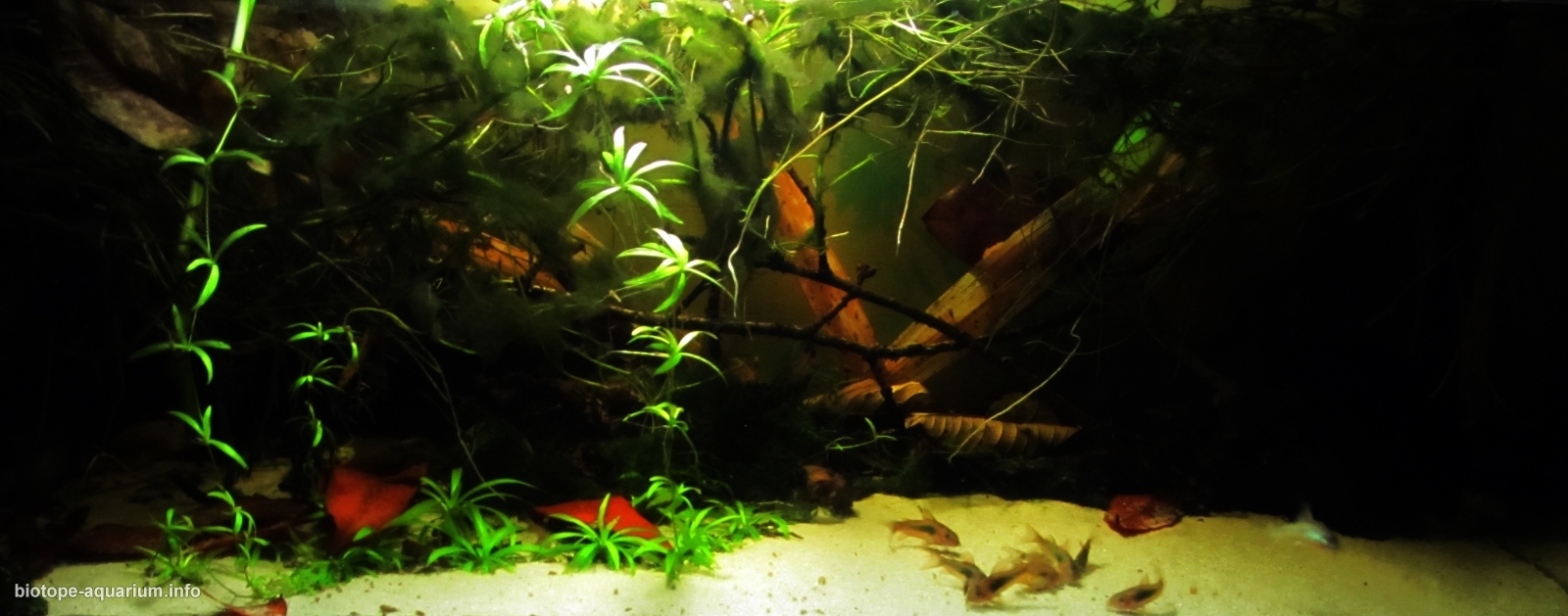Corydoras in Los Tres Gigantes Parque Nacional Río Negro, Paraguay
_th place in Biotope Aquarium Design Contest 2020

Volume: 160litres
Dimensions: 40 T x 40 H x 100 B cm
List of fishes: Corydoras aeneus Gill, 1858 als Hoplosoma aeneum, Corydoras paleatus Jenyns, 1842, Physidae: Melanoides tuberculata
List of plants: Echinodorus quadricostatus, Hydropogonella gymnostoma, Dracaena braunii, Chlorophyta (hair algae), Living root Monstera, Epipremnum aureum
Description of decorations: Leaves are in the background and occasionally stuck in the free-floating roots, with swamp and oak in between. The subsoil consists of 93% beige sand. The Hamburger Matten filter uses 7%. Hair algae are benevolent under the lighting in the roots and between the foliage. Here the appearance of the algae changes. Hydropogonella gymnostoma continues to delight.
Description of equipment: Filter: HMF Portable, Circulation with OASE pump 300l / h, Sponge (10Wx10Dx35H cm) service life 5 to 9 months. When cleaning the sponge, the filter housing remains in the tank. Decoration and animals are not disturbed. Lighting: Dehner Nano Amazon Day, 6000 Kelvin, 900 lumens
mid 10 am to 10 pm, No coverage
Water parameters: PH 7.5, GH 11.6, KH 11.0, nitrites 0, temperature Winter around 20 degrees, Summer up to 26 degrees
Additional info: My catfish live in a family group without being present. Age between 8 1/2 and 3/4 years. My aquarium shows a small lowland stream not far from the Los Tres Gigantes station. There is little light on the left due to the strong growth of grass. So there is illuminating in the middle. Dwarf sword plants try their luck on the ground, runners grow upwards – flood. Queen Moss adds. In the background, leaves are slowly weathering.
In the “sun” there is a larger free space in the front right, which is often used for resting the catfish (34 pieces). They live undisturbed among themselves. Therefore, when the front is quiet, the catfish scurry around the whole tank from time to time.
The aquarium is dimly lit. There is shade and sun without major obstacles, depending on the animals’ wishes.
Monstera and Efeutute have been feeding entirely on aquarium water for over 7 years. The narrow-leaved Lucky Bamboo imitates uniform grasses from the outside.
INFORMATION ABOUT BIOTOPE
Description of the area surrounding the biotope: Paraguayan Pantanal STATION “LOS TRES GIGANTES” 20 ° 11 ‘18.69 “S 58 ° 9’ 25.574” W
lies in the Río Negro National Park and belongs to the Pantanal area in the largest inland wetland in the world. Bahía Negra is the next town about 40km away. The area is still largely untouched, as it can only be reached by boat or military aircraft and has a unique flora / fauna.
Description of the underwater landscape of the biotope: Overgrown water landscapes, alternate with free, light sand areas, whereby the current also varies depending on the rainy or dry season, including the water temperature. Since I otherwise have little information, I used various underwater videos from the Amazon as a model.
Description of the parameters of the habitat: 2) pH 5.8-7.8 (7.0), 2-30 dH (10), 72-82 ° F (22) -28 ° C), The color of the water changes between the dry (brownish) and rainy season (clear).
List of fishes and invertebrates occurring in the nature biotope: Corydoras aeneus, Corydoras paleatus, Bemerkung: Durch das große Verbreitungsgebiet, ist es fraglich, ob es tatsächlich um beide Arten handelt. Moenkhausia sanctaefilomenae, Physidae.
List of plants found in the nature biotope: Echinodorus quadricostatus, Hydropogonella gymnostoma, Phyllanthus fluitans, Carapa guianensis, Hymenaea courbaril, Chamaedorea, Hura crepitans
Threats to the ecology: The Río Negro National Park is still largely untouched, thanks to managed, gentle tourism (difficult access). My tank should show an intact area and thus the beauty that needs to be preserved. I hope that the Alto Paraguay Department can achieve this.
Sources of information:
1) Habitat Corydoras by email from Mr. Erik Schiller
